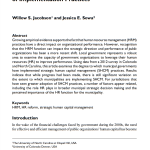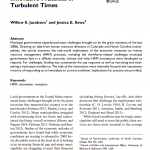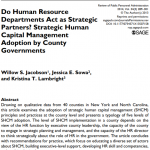Author: Jessica E. Sowa

Strategic Human Capital Management in Municipal Government: An Assessment of the Degree of Implementation Practices
Growing empirical evidence supports the fact that human resource management (HRM) practices have a direct impact on organizational performance. However, recognition that the HRM function can impact the strategic direction and performance of public organizations has been a more recent shift. Local government represents a robust area to examine the capacity of government organizations to leverage their human resources (HR) to improve performance. Using data from a 2012 survey in Colorado and North Carolina, this article examines the degree to which municipal governments have implemented strategic human capital management (SHCM) practices. Results indicate that while progress had been made, there is still significant variation on the extent to which municipalities are implementing SHCM. For jurisdictions that have seen greater adoption of SHCM practices, a number of factors appear related, including the role HR plays in broader municipal strategic decision making and the perceived importance of the HR function for the municipality.
Cite as:
Jacobson, W. S., & Sowa, J. E. (2015). Strategic Human Capital Management in Municipal Government: An Assessment of Implementation Practices. Public Personnel Management, 44(3), 317–339. https://doi.org/10.1177/0091026015591283
…
Continued
Focusing the Public Leadership Lens: Research Propositions and Questions in the Minnowbrook Tradition
Although there is no shortage of general studies and theories of leadership, the same cannot be said for public leadership. This concern surfaced as a critical issue among scholars at the 2008 Minnowbrook III conference. Drawing from that discussion, this article calls for invigorating the study of public leadership within public administration (PA). We present the case for public leadership, that is, leadership for the public good, where challenges are complex, stakeholders are many, values are conflicting, and resources are limited. Traditional, generic models of leadership—as in, leading followers toward some specific goal—do not align well with these current challenges. We argue for studying public leadership specifically, rather than trying to retrofit existing concepts of leadership from business management or elective politics. PA should be the leading voice in understanding and promoting public leadership. By examining previous public leadership scholarship through three broad lenses—the character of public leadership, the function of public leadership, and the jurisdiction of public leadership—we develop theoretical propositions designed to drive a revitalized research agenda. We conclude with a set of research questions we see as critical to crystallizing the significance of public leadership.
Cite as:
Heather Getha-Taylor, Maja Husar Holmes, Willow S. Jacobson, Ricardo S. Morse, Jessica E. Sowa, Focusing the Public Leadership Lens: Research Propositions and Questions in the Minnowbrook Tradition, Journal of Public Administration Research and Theory, Volume 21, Issue suppl_1, January 2011, Pages i83–i97, https://doi.org/10.1093/jopart/muq069
…
Continued
How Public Service Leadership is Studied: An Examination of a Quarter Century of Scholarship
This exploratory study surveys the public service leadership literature from a selection of leading public administration journals over a 25‐year period (1987–2012). Patterns in methods used to study public leadership are explored, along with how those methods vary across settings within the public service sector and the treatment of leadership in the analysis. While the number of empirical studies of public service leadership has grown, the diversity of theoretical approaches, methods and measures challenges the ability to synthesize findings in order to advance the knowledge base on this topic. This article provides a map of leadership studies within the field of public administration over time and offers prescriptions for future research.
Cite as:
CHAPMAN, C., GETHA-TAYLOR, H., HOLMES, M., JACOBSON, W., MORSE, R. and SOWA, J. (2015). HOW PUBLIC SERVICE LEADERSHIP IS STUDIED: AN EXAMINATION OF A QUARTER CENTURY OF SCHOLARSHIP. Public Administration, 94(1), pp.111-128.
…
Continued
Municipal Human Resource Management: Challenges and Innovative Practices in Turbulent Times
Municipal governments experienced many challenges brought on by the great recession of the late 2000s. Drawing on data from human resource directors in Colorado and North Carolina municipalities, this article examines the real-world implications of the economic recession on human resource management (HRM) practices, including the workforce-related challenges municipal governments face in a difficult economic climate and what HRM innovations were developed to respond. For challenges, funding was consistently the top response as well as recruiting and maintaining a motivated workforce. The bulk of the innovations were internally focused and reactionary in terms of responding to an immediate or current condition. Implications for practice are provided.
Cited as:
Jacobson, W. S., & Sowa, J. E. (2016). Municipal Human Resource Management: Challenges and Innovative Practices in Turbulent Times. State and Local Government Review, 48(2), 121–131. https://doi.org/10.1177/0160323X16658696
…
Continued
Do Human Resource Departments Act as Strategic Partners? Strategic Human Capital Management Adoption by County Governments
Drawing on qualitative data from 40 counties in New York and North Carolina, this article examines the adoption of strategic human capital management (SHCM) principles and practices at the county level and presents a typology of five levels of SHCM adoption. The level of SHCM implementation in a county depends on the view of the HR function by executive county leadership, the capacity of the county to engage in strategic planning and management, and the capacity of the HR director to think strategically about the role of HR in the government. The article concludes with recommendations for practice, which focus on educating a diverse set of actors about SHCM, building executive-level support, developing HR skill and competencies, and applying basic change management practices.
Cite As:
Jacobson, W. S., Sowa, J. E., & Lambright, K. T. (2014). Do Human Resource Departments Act as Strategic Partners? Strategic Human Capital Management Adoption by County Governments. Review of Public Personnel Administration, 34(3), 289–301.
…
Continued
